Backwashing clears out the dirt and gunk from your pool’s filter. Whether you have a sand filter or a DE filter, it will need backwashing from time to time. In this article I’ll tell you why you need to backwash, when to backwash and give you step-by-step instructions on how to backwash your pool’s filter.
To backwash, a sand or DE filter, turn off the pool pump and attach a backwash hose. Then set the valve to “backwash”, switch the pump back on and let the water flow out until it is clear (usually about 2 mins). You’ll need to next set the valve to rinse after for about 30 secs. If you have a DE filter, you’ll to refill the DE.
Of course, that was the extremely short version. There’s more to it than that. In this article we cover inground pools, above ground pools, saltwater pools. In addition, you’ll find these procedures will work for many brands, including:
- Pentair
- Intex
- Hayward
- Jandy
- RX Clear
- Astral
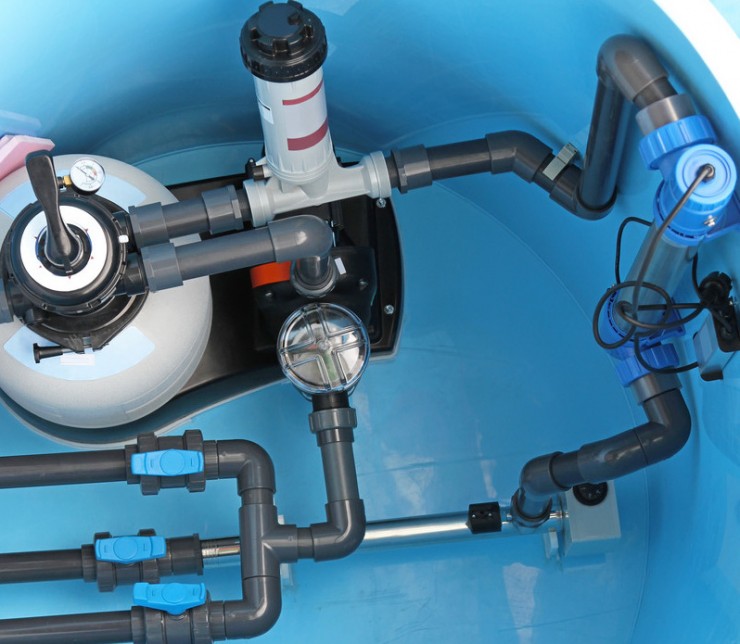
Article Contents
What is Backwashing?
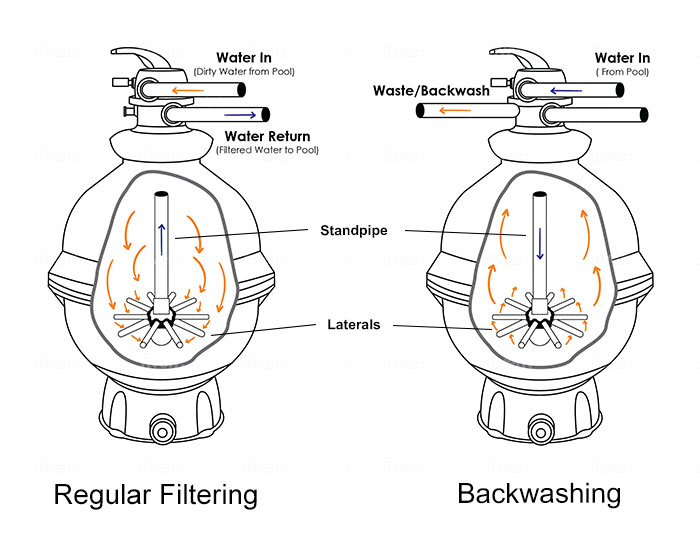
Backwashing or backwash reverses the flow of water through the pool’s filter, lifts up and flushes the filter medium (sand or DE), and then expels the dirty water via a waste line into the ground or drain. Sometimes this is also referred to as backflushing.
Backwashing is essentially the process of cleaning the pool filter and needs to be done on a regular basis. More on that later.
In order to ensure against residual blowback into the pool, once you’ve finished backwashing it is highly advisable to rinse the filter. Just as the backwash lifts and flushes the sand or DE, the rinse reseats the sand or DE in its original position for optimum filtration.
Note: Backwashing reduces the water level in your pool. You should refill the water, check the water quality and balance the chemicals as needed. To maintain the chlorine level, you may have to use more chlorine tablets. Here’s how to calculate the right amount of chlorine tablets for your pool size and type.
Read on to learn how to backwash your pool.
Why Should You Backwash?
All DE (diatomaceous earth) and sand filters use the same basic mechanics: when set to “Filter”, water flows from the pool, through the filter, and back into the pool. The filter medium (sand or DE) inside the filter system blocks debris, dirt, and oil. A typical pool filter multiport system has 6 different settings – Filter, Backwash, Rinse, Circulate, Closed, and Waste.
However, over time, or when you vacuum your pool, dirt and debris get deposited in the filter – the result being that the filter becomes dirty and clogged with contaminants that, if left unchecked, will reduce the filter’s ability to clean and if left could restrict the water flow and put extra strain on the pool.
Reasons to backwash a filter:
- To reduce high filter pressure
- To help with cloudy pool water
- To clean the filter after algae treatment
- To clean the filter after cleaning an extremely dirty pool
- Filter doesn’t seem to be working well
A dirty filter also means increased or high filter pressure. Usually the pressure is considered high if it’s about 20 or 30 psi. But it depends on what’s normal for your filter. More on that later.
Pools can get cloudy of the filter is blocked up or not working well. So if your saltwater pool is cloudy, or your chlorine pool is, it may be a good idea to backwash the filter to clean it out.
How to Backwash a Sand Filter
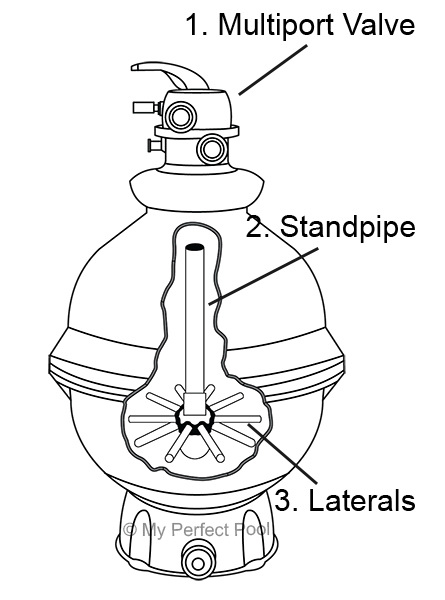
A pool sand filter uses sand to catch contaminants in your pool’s water. Pool water is circulated through special filter grade pool sand.
From time to time, you will need to clean your sand filter by backwashing it. Here’s how to backwash a sand filter:
- Turn off the pool pump.
- Set the sand filter valve handle to the BACKWASH pool position and ensure the handle locks in place.
- Turn on the pump and backwash for 2 minutes or until the water in the sight glass (located on the filter) is running clear.
- Turn Off the Pump.
- Set the filter valve handle to the RINSE position and ensure the handle locks in place. Note: if you don’t rinse, the filter may put dirt back into the pool.
- Turn on the pump and run the rinse process for 30-60 seconds or until the water in the sight glass is clear.
- Turn Off the Pump.
- Close the skimmer valves to prevent water from entering the filter from the pool. Empty the filter skimmer basket and clean out the hair catcher.
- Re-seat and seal the skimmer basket and hair catcher.
- Reopen the skimmer valves.
- Reset the Filter Valve to Filter and ensure the handle locks into place.
- Turn On the Pump.
How to Backwash a DE Filter
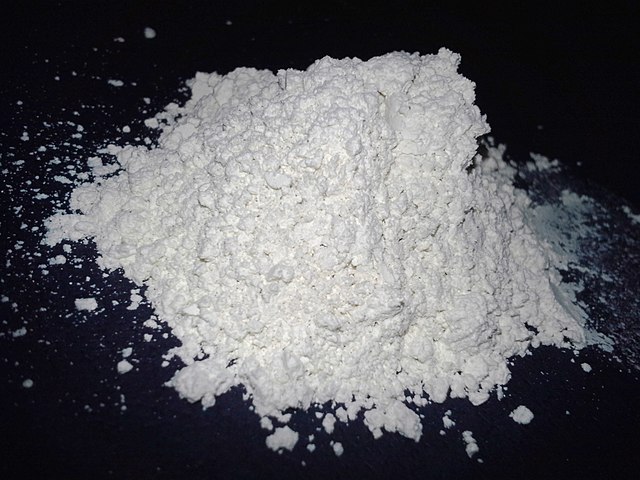
A DE filter uses Diatomaceous Earth (DE for short) instead of sand to catch contaminants. D.E. is a much finer medium than sand and therefore does a better job at filtering your pool water. However, there is some extra maintenance required when backwashing.
Backwashing a D.E. Filter is similar to a sand filter with one extra step of topping up the diatomaceous earth.
Important: before you start, make sure you have some D.E. powder on hand, as you’ll need to top up the filter after backwashing. DE gets washed out when backwashing.
How to Backwash DE Filters (With Multiport Valves):
- Switch off the pool pump.
- Select the BACKWASH setting on the filter valve.
- Turn the pump back on and backwash until for 2 minutes or until the water runs clear (you can check this in the sight glass on the side of the filter).
- Turn the pump off.
- Select the RINSE setting on the filter valve.
- Turn the pump back on and rinse for 1-2 minutes. You can repeat steps 2 to 6 a few times if the filter is particularly dirty.
- Turn the pump off and select FILTER
- Refill D.E. powder.
- Check the manufacturer’s instructions as to how much. It will likely be 3-6 lbs (or about 80% of the full capacity of the filter).
- Usually you will add this to the skimmer (mix the DE with water first) and/or you’ll add some D.E. powder in the pump strainer and the rest in the skimmer. Again check the manufacturer’s instructions.
- Run the pump on the FILTER setting for 30 minutes or more to allow the D.E. powder to coat the filter grids again.
How to Backwash DE Filters (With Push-Pull Valves):
The backwashing procedure for DE filters with push-pull valves is almost the same as backwashing a DE filter with a multiport valve.
- Switch off the pool pump.
- Open the valve to BACKWASH.
- Turn the pump back on and backwash until for 2 minutes or until the water runs clear (you can check this in the sight glass on the side of the filter).
- Turn the pump off.
- Close the push/pull valve.
- Refill the D.E. powder.
- Check the manufacturer’s instructions as to how much. It will likely be 3-6 lbs (or about 80% of the full capacity of the filter).
- Usually you will add this to the skimmer (mix the DE with water first) and/or you’ll add some D.E. powder in the pump strainer and the rest in the skimmer. Again check the manufacturer’s instructions.
- Run the pump for 30 minutes or more to allow the D.E. powder to coat the filter grids again.
Related Reading: What is a Filter Backwash Sock? (Do You Need One?)
Can You Backwash a Cartridge Filter?
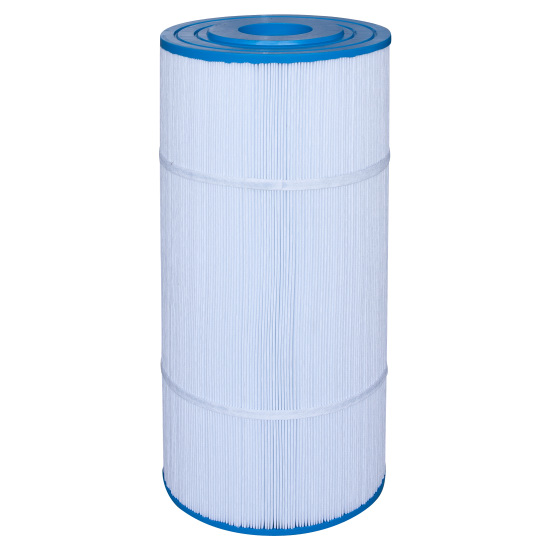
Pool cartridge filters cannot be backwashed unlike their cousins sand filters and D.E. filters. Cartridge filters are not designed to run “backwards”.
However cartridge filters can and should be cleaned on a regular basis. To clean a cartridge filter you’ll need to open the filter up and remove the cartridge. Rinse and spray the cartridge with the hose every 4 weeks and give it a deep clean every few months.
We have full instructions to deep clean your cartridge filter in our blog here:
How to Clean Pool Cartridge Filter (Using Muriatic Acid)
How Often to Backwash Pool
As a rule of thumb, regardless of if you have a sand filter or DE filter, you should backwash your pool about once a week during swimming season. The optimal time is right after you vacuum the pool. If your pool has had a lot more use than normal, it may be necessary to backwash twice a week.
We recommend this suction cleaner and this robotic cleaner.
| Image | Product | Features | Link |
|---|---|---|---|
 |
| 9.7 | Check Price |
 | XtremepowerUS Automatic Suction Vacuum
| 9.5 | Check Price |
Also, if your pool is particularly prone to leaves, more frequent backwashing may be necessary since leaves, other debris from trees, and contaminants from birds etc. will be entering your pool.
You can also tell when it is time for a backwash by checking the filter’s pressure gauge. Normal operating pressures are between 50 and 170 Kpa (kilopascal) or 10 – 25 psi. When the sand gets dirty and clogged up, however, the pressure reading rises.
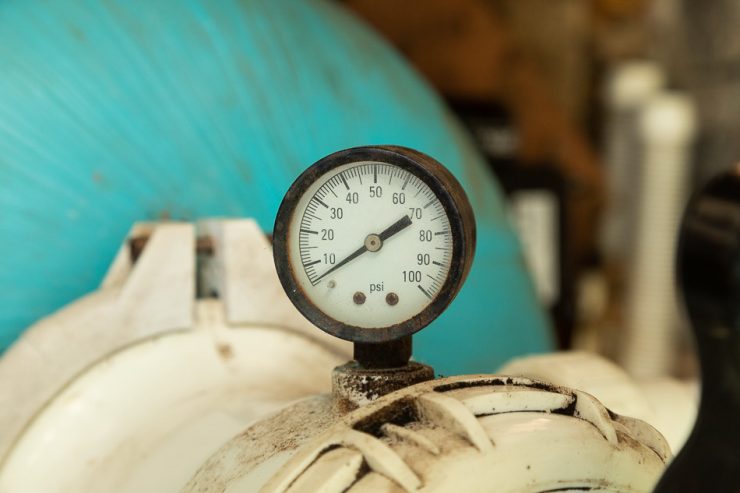
If the pressure on the gauge is showing 5-10 psi higher than normal, it’s time to backwash.
If you have already backed washed your pool and the pressure is still high, check out our article: 8 Reasons Filter Pump Pressure is High (And How to Fix)
One thing to note about high pressure, it can cause the pump to work extra hard. It may even trip the breaker. So it’s important to make sure the filter pressure is in normal range.
Help: Backwashing Didn’t Lower the Pressure
Usually after you’ve finished backwashing, the pressure in pool filter will lower and go back to a normal level. It is possible that sometimes, no matter how many times you backwash, the pressure remains high.
In this case, you may consider deep cleaning your filter:
How to Deep Clean a Sand Filter (And Change Sand)
How to Clean Pool Cartridge Filter (Using Muriatic Acid)
When Not to Backwash
If your pool contains an unusually high level of dirt (for instance, as a result of a nearby construction site, a protracted period of being untended and uncovered, or possibly from runoff caused by flooding) it may be advisable to by-pass the filter entirely.
This is also the case if your water had, or has had, an algae problem. Live algae easily pass through the filter sand and re-enters the pool. And the same goes for dead algae following a shock treatment. You can read more on preventing algae here.
In these cases, instead of vacuuming and backwashing, it may be better to vacuum directly to WASTE, and to send the vacuumed water directly down into the drain.
Where to Get Rid of Backwash Water
When you backwash your pool there will be quite a bit of water to deal with. You need to have a plan before you start. A few hundred gallons of water flooding onto your neighbors’ properly will likely result in you not being invited to their next Christmas party.
Your Yard
Disposing of pool backwash water in your own yard is the recommended option. You’ll find in many states and councils that it is illegal to dispose of pool water in the drain or sewer.
Make sure you keep the water on your property, though. Some councils issue fines if poolwater runs off.
Will it kill the grass or plants? In most cases, your grass should be fine if you route your backwash water there. You may consider moving the hose around as you are discharging the water, so the water doesn’t accumulate in one spot.
Also, make sure it’s not going to run into your house or anywhere else.
As for plants, pool water will kill some plants but many of them will be fine, as long as they don’t have too much pool water on them.
Gutter or Storm Drain
In many places, it’s illegal to discharge pool water into the street, gutter or stormwater drain unless it’s been decontaminated. This water will often end up in rivers, creeks, lakes and oceans. Pool water typically contains a range of chemicals that could be detrimental to the local environment.
Sanitary Sewer via Cleanout
In some areas, it’s OK to dispose of pool water here. It’s not normally OK to have your pool permanently plumbed into the sewer though. Check with your local council to find out if this is an option for you.
Important Backwashing Tips
- The one downside of backwashing is that, because water is expelled from the system and sent into waste, is that it…well…wastes water. While this is unavoidable, the key to not overdoing the backwash process and flushing out more water than strictly necessary is to keep a careful eye on the colour and quality of the water in the sight glass.
- Don’t backwash more than necessary, or for longer than necessary. Sand filter systems operate most efficiently during the middle of the filtration cycle. This is partly due to the positioning, at any given time, of the sand in the filter, and partly because of the cyclical build-up of collected dirt and debris in the filter. The net effect is that too much or to frequent backwashing actually reduces the sand filter’s efficiency.
- Because backwashing inevitably washes out some of the sand along with the dirt and debris, from time to time it will be necessary to top up the amount of sand in the filter. When you do add extra sand, run the filter system on RINSE for a minute or so to reduce the amount of sand blowback into the pool. We recommend this replacement filter sand here.
- Finally, absolutely make sure you always turn off the pump before you either move or reset the filter valve setting. If you don’t, you’re going to damage, and maybe destroy the system.
Recommended Products
Swimming Pool Vacuum – Automatic Suction Cleaner or Robotic Cleaner
Related reading:
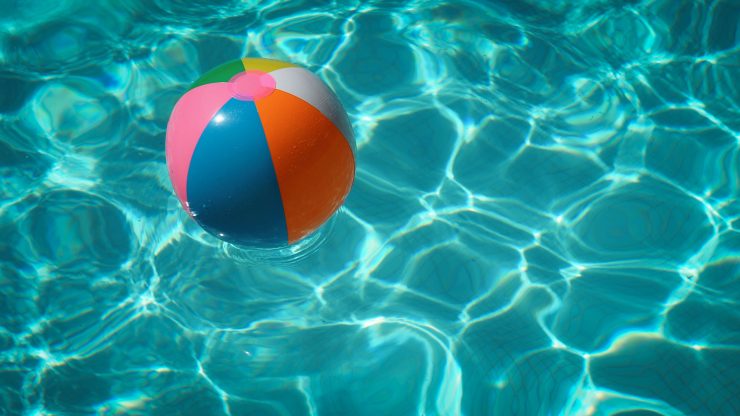


Great write up. Had been following similar except the “rinse” mode for our DE filters. Will add that to the regime. I also take the filter system apart and hose them off every 3-4 months then fully refresh the DE. I noticed a crack in the top manifold when my pool was cloudy. After replacing that the pool was super clear.
Thank you for the help. We have a 24’ round above ground pool. New jun 2018, this summer I am having trouble with it staying clean. We opened and inspected the sanded, it was a little dirty and had some clumps in it but over all in pretty good shape. I was making the mistake of backwashing too often I think. But now when we backwash then rinse the pump still blows dirty water back in my pool for just a couple of seconds. I have a Haywood xl vary flow pump head and I took the top off , the spider gasket looks fines but is very flat I wonder if it could be leaking.
Check your pool filter. It may need cleaning or the filter medium may need replacing. Or if it’s a sand filter you may have cracked laterals or a cracked stand pipe (located inside the filter). It may also be that whatever is making the water look dirty is too fine to be picked up by the filter. You could try flocculant and then manually vacuuming. Make sure you vacuum to waste or you’ll clog the filter. I would use floc as a last resort though.
But enough about what backwashing is, let us get to the meat of the issue. When should you backwash your pool filter?
Once I backwash and rinse, Do I have to refill my above ground pool with water once im done?
When you backwash you will be draining some of the water. If the water level is too low (below the skimmer box), you can top up your pool again.
Water clarity – cloudy water may indicate that the filter media is dirty or unable to catch the dirt and debris making its way into your pool
Yes absolutely. Cloudy water is the symptom of something not right in your pool. It could be a chemical imbalance, equipment issue, environmental or something like algae.
Thanks for the info on back wash and rinse cheers Mick Bertram
When you talk of a dirty filter you say: “the sand becomes dirty and clogged with contaminants that, if left unchecked, will reduce the sand’s ability to filter”. This is not true. Any dirty filter in fact filters better than a clean one, because smaller particles fill in the empty spaces in between the filter medium and trap even smaller particles that would otherwise pass through unfiltered. Even motor car air filters filter smaller particles more efficiently when dirty. The correct answer is not that the filter fails to clean, but that more pressure is required to maintain flow, resulting in a drop in efficiency.
I have learned a lot from this article. I really love your title and you mentioned many key factors and straight to the point reminders with us. Thanks for sharing this one!
The sand is the filter
Awesome info. A beginner could understand and follow your directions. Thanx
We have wastewater facility which used the same system but we backwash 2-3 times per day at 3-5 minutes every backwash. I replaced the sand filter but nothing happened. I also noticed that during backwash, the dirt was not completely out. We used sugar grade filter. Any suggestion is much appreciated…
how often do you change the actual filter? not the sand but the actual sand filter. mine is 15 years old and i was wondering if i should change it when i change the sand…any help would be good. its not leaking or anything just considering the age of the sand filter
I change mine yearly. The cost of changing is minor compared to a sand filter that is inadequate. I’m surprised your 15 year old sand is even capable of filtering.
I just looked over your post again. Sorry. Your “filter” doesn’t need to be replaced unless it is damaged in some way.
We are having a major water shortage and so I am reluctant to backwash any water out of the pool.
Can I backwash the water back into the pool but first through a mesh filter or something ???
how come we back washed was ok but when we put the pump back on it started back washing again automatically.
If your filter valve is set to filter, and you are still losing water out of the backwash valve, the seal in your control head is damaged.
Our current pool (Expert) continues to do whatever he feels is correct with the maintenance of our in-ground cement pool.
A couple of months ago, I caught him using the multi port valve whilst he had the pump running, I gave him a reprimand, though unfortunately the fairly new sand filter was damaged soon after & had to be replaced ???
We have needed 2 rebuilds on the pump already & a new replacement just yesterday, this morning during his twice weekly visit he had the pump on & off 6 times within 5 minutes ???
Another issue, instead of using the Manual / Start switch on the control panel he turns the timer control to an ‘ON’ sequence to vacuum etc,. So after every visit I have to physically reset the pump timer otherwise the pump / water feature & pool lights are not in sequence.
Any suggestions…..
Andrew.
Fire that pool guy and hire someone competent or take over maintenance yourself.
Hi i need help please. Is the Backwash the same as waste knob? I only have 4 knobs, backwash, rinse, filtration and winter. Above ground 10,000 gal with sand filter. I’m trying to get green algae out, but it come back in when I clean? Any help thank you
Yes, learn to check your own water chemicals, and get an autovac system. No need for pool up. Take 10 min to throughly check your water chemicals.
Fire him
We have a new pool. We are in the deep south with an infinity edge pool. Our gardener back flushed the sand filter drawing water from the over flow canal. It seems the dirtiest water available! Shouldn’t we be drawing water through the filter from the skimmer near the top of the pool the water is clean, sending through the filter to waste and not from the overflow canal where all the bugs and detritus id caught? (he did vacuum the entire pool first through the filter including the canal). So the water in the overflow wasn’t as dirty as usual.
This is very well written and informative! We have a new filter and pump that was just installed for out 30,000 gal inground pool. The previous owner told me to only backwash if I saw air bubbles coming from the jet. I’m confident after reading your post that we will be able to properly clean and care for our pool. Thank you for taking the time to write and post this!
Looks like I’ve been doing it wrong! I thought back washing removed all the sand so I always added it all (4 & 1/2lbs) each time I back washed. Then again I only back washed once twice a month max during the season. I primarily vacuum with the robot so not a lot of debris ended up in the filter. Thanks for the tip!
I have 4 valves on my system. how do I know the purpose of each each back flushing
Dude. You just nailed it. Covered everything. Bravo
Excellent – very informative, thank you
Glad to hear you find the site useful!
A very awesome blog post. We are really grateful for that blog publish. There’s also a lot of approaches after visiting your publish. I used to be exactly looking for. Appreciate such publish and please keep writing. Great work.
Great help, many thanks
Hi there. I had my sand changed about a year ago. I did have some green algie, so shocked and vacuumed, but not to waste. Since then it has been a constant cycle of shock, yellowey algie (or something) sat at the bottom, vacuum and whilst vacuuming the returned water is cloudy, so need to shock again. I have back washed and rinsed until clear is seen in the peep hole. Can you tell me what is could be?
Do you ever need to change the sand in a sand filter? My semi above ground liner pool is constantly murky. The filter seems to be working fine and has a lot of pressure when you see water going through but the pressure gauge is always sitting just above zero? Seems something’s not right somewhere. We’ve drained, cleaned, refilled, back washed and all chlorine, ph, alkaline and stabiliser levels are fine. The filter is only about 8 years old. Help!!!!
Yep you should change the sand. The sand loses it’s edges with time. Most filter manufacturers recommend every 3-5 years. Every 5 years is fine.